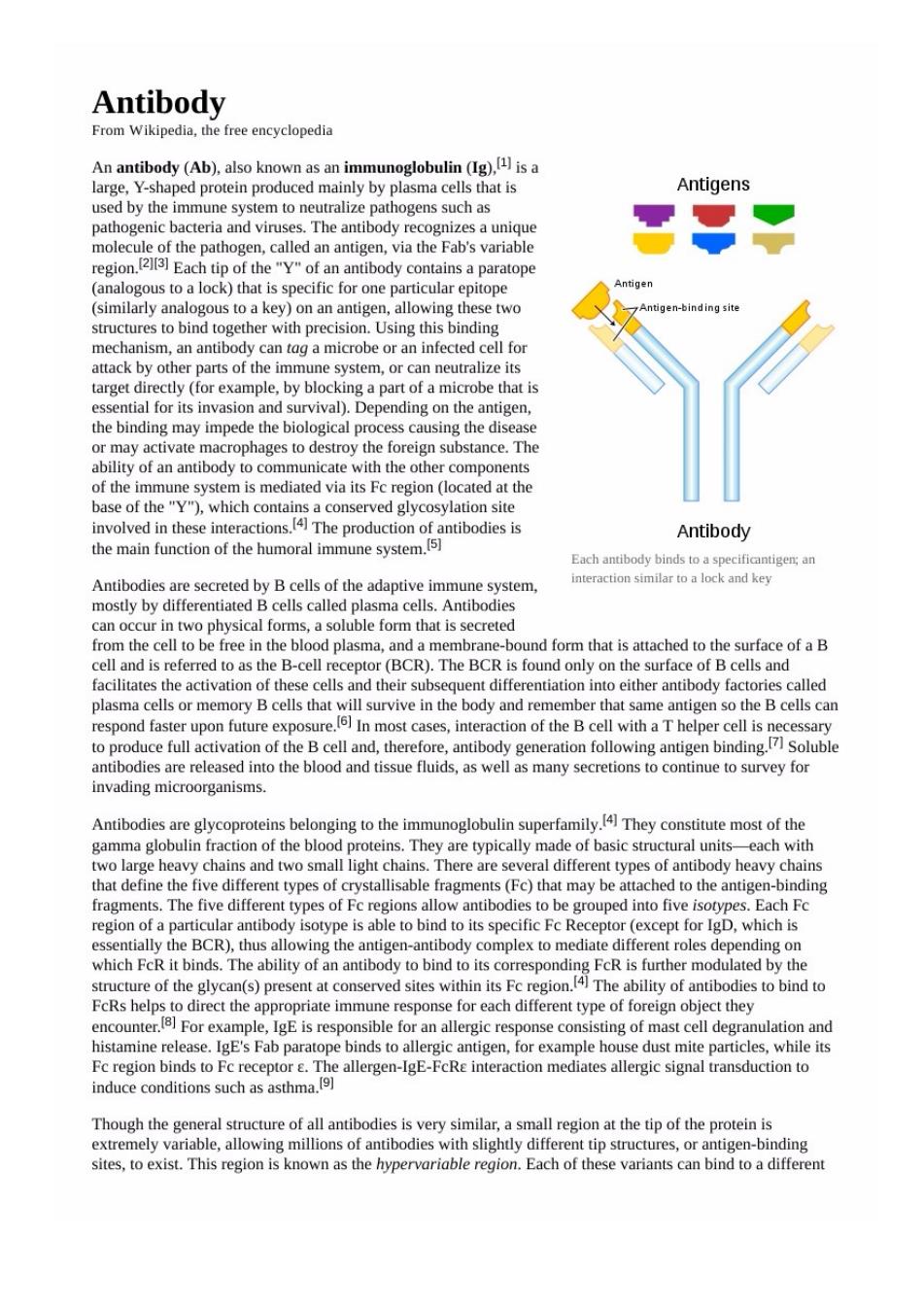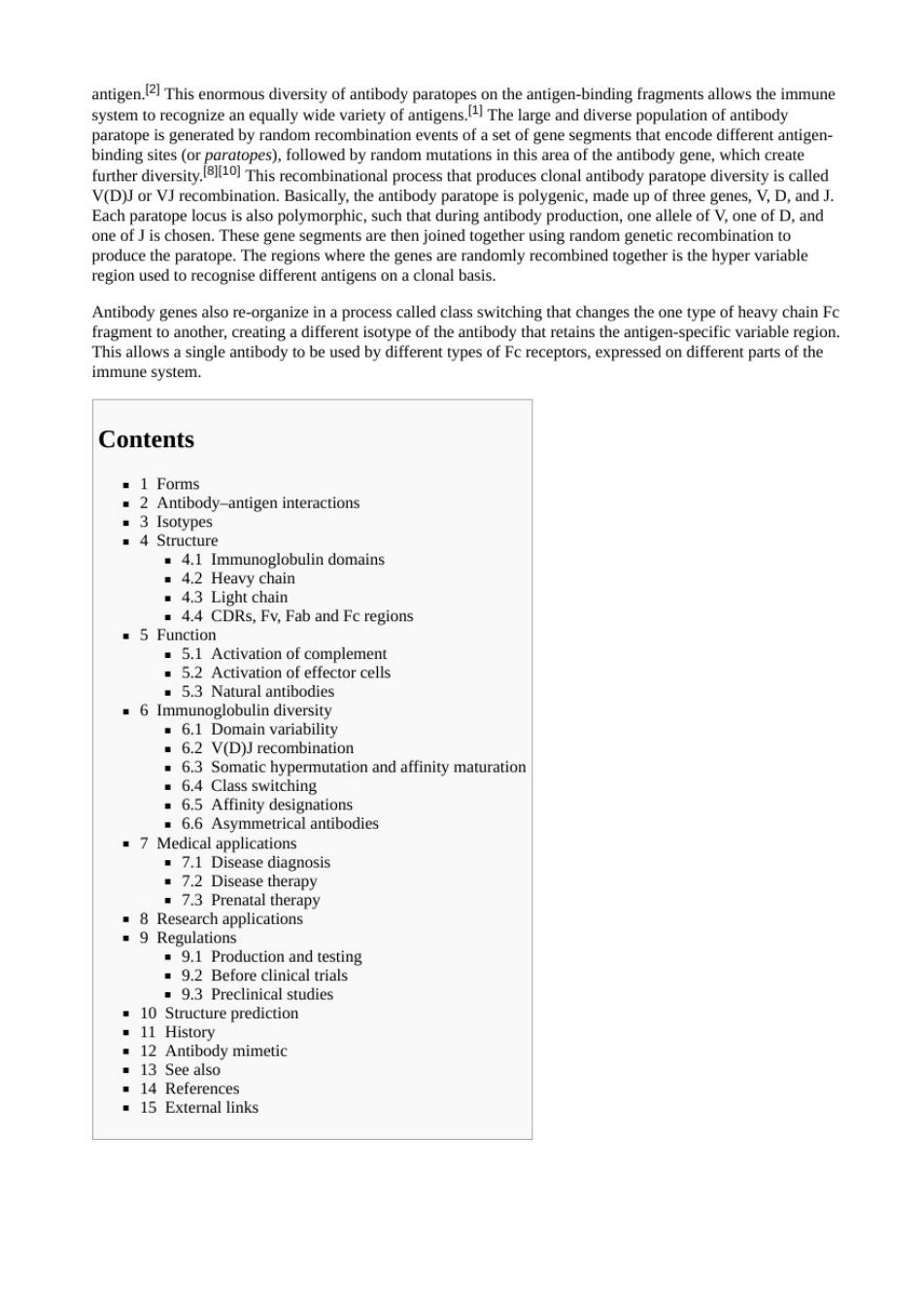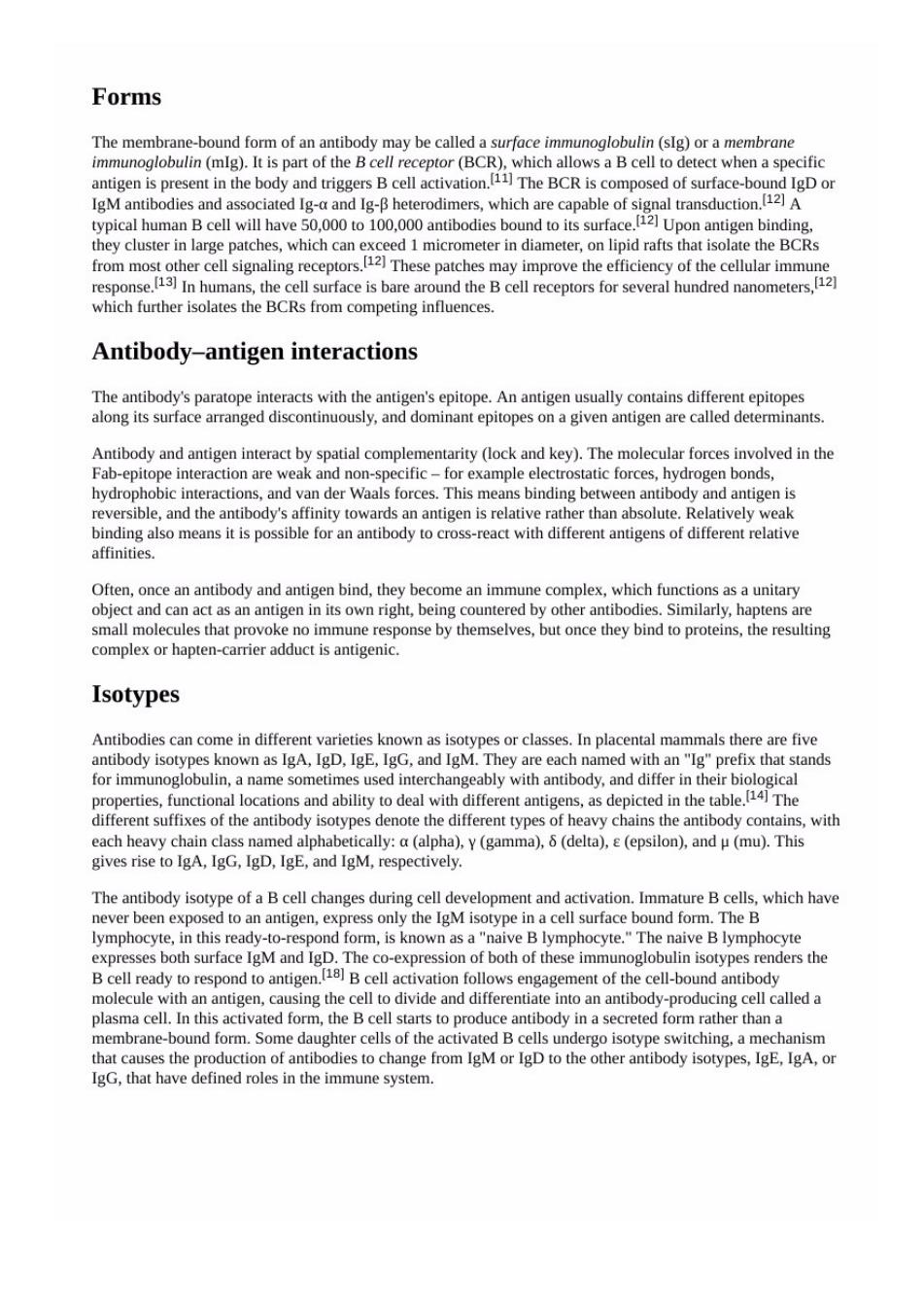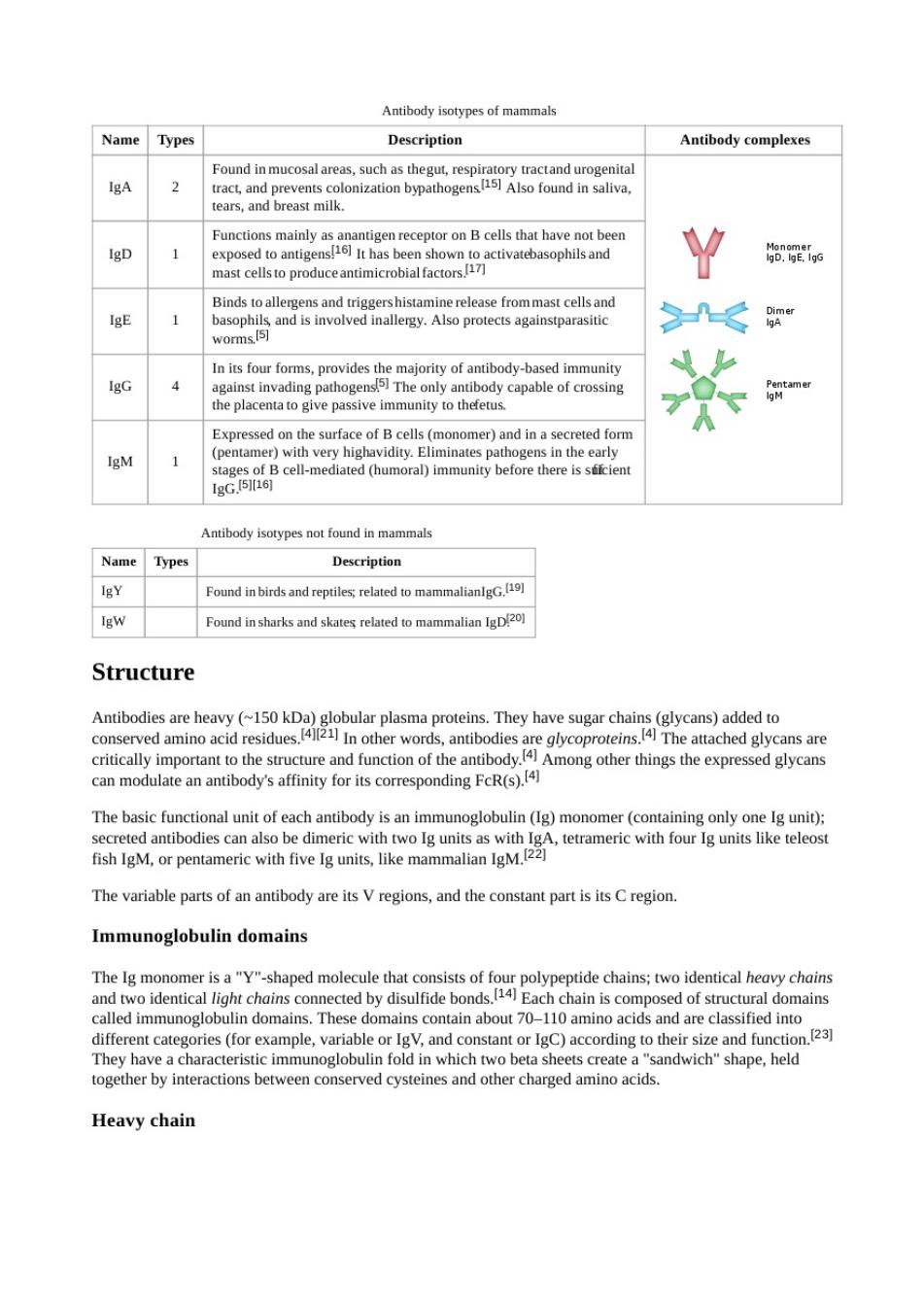
01-Antibody
01-Antibody

Antibody From Wikipedia,the free encyclopedia An antibody(Ab).also known as an immunoglobulin(Ig).is a large,Y-shaped protein produced mainly by plasma cells that is Antigens the pathogen,called an ar region.Each tip of the"Y"of an antibody contains a paratope (analogous to a lock)that is specific for one particular epitope (similarly anal ogous to a key)on an antigen. allow ing these two gen-bind ing s el for attack by other parts of the immune system,or can neutralize its target directly (for example,by blocking a part of a microbe that is for its invasi ial).Depending on antigen, the foreign substance.The ability of an antibody to communicate with the other components of the immune system is mediated via its Fc region(located at the e of th on site h )which a con 0nn尚n bodies9 Antibo小y mmune syste ntibodies re secrete adaptive toa lock and key immune system, E sty by sical fo that is from the celtobe freen the.and a membrane-bound form that is attached to the surface of a B cell and is referred to as the B-cell ceptor(BCR).The BCR is found only on the surface of B cells and to either antibody fact ,61 of the B cel to produce full activation of the B cell and,therefore,antibody generation follow ing an n binding.Soluble antibodies are released into the blood and tissue fluids,as well as many secretions to continue to survey for invading microorganisms. Antibodies are gly coproteins belonging to the immunoglobulin superfamily4]They constitute most of the amma globulin fraction of the blood proteins.They are typically made of basic structural units-each with two large heavy chains and two small light chains.There are several different types of antibody heavy chains that def e five different types of fragments(Fc)that may be a ach d to the antige inding able to hind to its ep which is essentially the BCR).thus alowng the complex to mediate different role dependingon he ycn)preet at comerdThe ftbdibind The ability of antibodies to bind to ect th or eacn c rent type of ey histamine release a's Fab parat binds to all raic antigon for 黑高Re欧gan0 Though the general structure of all antibodies is very similar.a small region at the tip of the protein is extremely variable,allowing millions of antibodies with slightly different tip structures,or antigen-binding sites,to exist.This region is known as the hypervariable region.Each of these variants can bind to a different

antigen.2]This enormous diversity of antibody parato on the antigen-binding fragments allows the immune system to recognize an equally wide variety of antigens.The large and diverse population of antibody paratope is generated by random recombination events of a set of gene segments that encode different antigen- mgs品9ps,6 ed byndomhothe8心.hcr binding sites (o nis recom national process that produces clonal antibody paratope diversity is call e of D,and one of J is chosen.These gene segments are then joined together using random genetic recombination to 一hen0peeL y that retains the antigen-spe Contents .4.1 Immunoglobulin domains .4.2 Heavy chain CDRs.FV.Fab and Fc regions .5 Function 5.3 Natural antibodies ·6 :品 .6.3 Somatic hypermutation and affinity maturation .6.6 Asymmetrical antibodies Os)

Forms The membrane e-bound form of an antibody may be called a surface im unoglobulin(slg)or a membrane B The BCR】 when a specifi duction.o Iicrometer in diameter,on lipd afs that the BCRs 一器 trom competing intluences Antibody-antigen interactions determinants Antibody and antigen interact by spatial complementarity (lock and key).The molecular forces involved in the h n is relativ e rather than absolute.Relatively binding also means it is possible for an antibody to cross-react with different antigens of different relative affinities. Often,once an antibody and antigen bind,they become an immune complex,which functions as a unitary object and can act as an antigen in its own right,being countered by other antibodi es.Similarly,haptens are ct is antigenic Isotypes mammals there are five manmh each heavy cha cally:a(alpha),Y(gamma),(delta),(epsilon),and u(mu).This The antibody isotype of a B cell changes during cell development and activation.Imm never been ex to an antigen,express only the IgM IgM and IgD.The co- B cell ready to respond to antigen.]B cell activation follows engagement of the cell-bound antibody molecule with a n antigen,causing the cell to divide and differentiate into an antibody-producing cell called a plasma cell. In th ted form,the B c rther than a the ion of ant IgG,that have defined roles in the immune system

Antibody isotypes of mammals Name Types Description Antibody complexes 2 M exposed to antige ooaivabasophand .g antimicro Binds to allerg 1 gens and triggershistamine release frommast cellsand -≤ In is four forms,provides the mjority of antibody-based immuiy Expressed on the surface of B cells(monomer)and in a secreted form gM ges of Bumoral)immunity before there is srien Antibody isotypes not found in mammals Name Types Description IgY Found inbirds and reptiles;related to mammalian Igw Found insharks and skates related to mammalian ID Structure lobular che critically can modulate an antibody's affinity for its corresponding FcR(s). The basic functional unit of each antibody isan imm with unoglobulin(Ig)m with fish IgM,or pentameric with five Ig units,like mam malian IgM.(2 The variable parts of an antibody are its Vregions,and the constant part is its C region Immunoglobulin domains The monomer shped moleculehatsf opolypepide chainseichns Each chain is composed of structural domains n domains.The contain about 70 s and are clas d 23 fold in whichw a"sandwich"shape.held together by interactions between conserved cysteines and other charged amino acids. Heavy chain